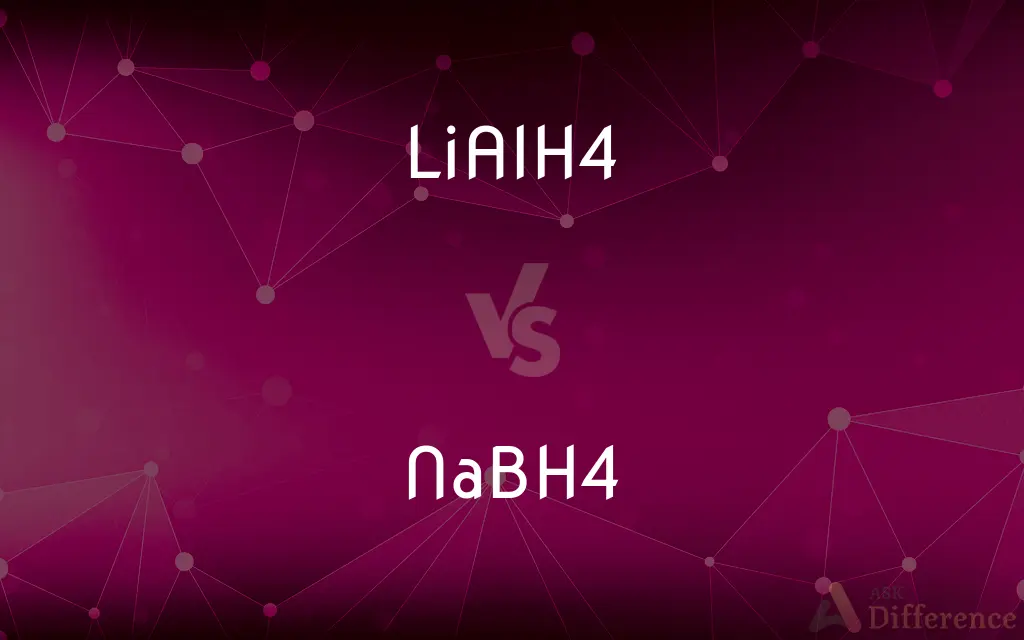LiAlH4 vs. NaBH4 — What's the Difference?
By Tayyaba Rehman & Fiza Rafique — Published on February 16, 2024
LiAlH4 is a strong reducing agent that can reduce esters, carboxylic acids, and amides, while NaBH4 is milder and typically reduces aldehydes and ketones.

Difference Between LiAlH4 and NaBH4
Table of Contents
ADVERTISEMENT
Key Differences
LiAlH4 (Lithium Aluminium Hydride) and NaBH4 (Sodium Borohydride) are both widely used reducing agents in organic chemistry, but they differ significantly in strength and application. LiAlH4 is more potent, capable of reducing a wide range of functional groups, including esters, carboxylic acids, amides, aldehydes, and ketones to alcohols. It is reactive towards water and requires anhydrous conditions and inert solvents like diethyl ether. On the other hand, NaBH4 is less reactive, primarily used for the reduction of aldehydes and ketones to alcohols, and can tolerate mild aqueous conditions.
LiAlH4's aggressive reactivity makes it unsuitable for selective reductions when multiple functional groups are present that could be reduced. It demands careful handling due to its violent reaction with water, producing hydrogen gas. NaBH4 offers a milder alternative, allowing for selective reduction in the presence of other sensitive functional groups and is safer to handle in typical laboratory settings due to its stability in water.
The choice between LiAlH4 and NaBH4 depends on the desired outcome of the reaction and the nature of the substrate. For complex molecules requiring specific group reductions without affecting other functional groups, NaBH4 is often the preferred choice. Conversely, for more comprehensive reductions, LiAlH4 is utilized despite its handling precautions.
While LiAlH4 is typically used in anhydrous solvents to prevent decomposition, NaBH4's compatibility with aqueous solutions expands its utility in more varied reaction conditions. This characteristic makes NaBH4 more versatile for reductions that can tolerate or benefit from aqueous environments.
The distinct reactivity profiles of LiAlH4 and NaBH4 highlight the importance of selecting the appropriate reducing agent in synthesis strategies. Understanding their differences is crucial for successful organic transformations, impacting both the efficiency and safety of chemical reactions.
ADVERTISEMENT
Comparison Chart
Reduction Strength
Stronger, reduces a wide range of functional groups.
Milder, mainly reduces aldehydes and ketones.
Reactivity with Water
Highly reactive, violent with water.
Relatively stable in water.
Preferred Solvent
Anhydrous conditions, like diethyl ether.
Can be used in aqueous or mixed solvent systems.
Functional Groups Reduced
Esters, carboxylic acids, amides, aldehydes, ketones.
Primarily aldehydes and ketones.
Safety and Handling
Requires careful handling due to reactivity with water.
Safer to handle, less reactive with water.
Compare with Definitions
LiAlH4
LiAlH4 can reduce a broad spectrum of functional groups.
The amide was efficiently reduced to an amine using LiAlH4.
NaBH4
NaBH4 is compatible with mixed solvent systems.
The reaction with NaBH4 was conducted in a mixture of water and ethanol.
LiAlH4
LiAlH4 reacts violently with water, producing hydrogen gas.
LiAlH4 must be handled under anhydrous conditions to prevent a hazardous reaction.
NaBH4
NaBH4 is a milder reducing agent, primarily for aldehydes and ketones.
NaBH4 was chosen to selectively reduce the ketone to an alcohol.
LiAlH4
LiAlH4 is a potent reducing agent used in organic synthesis.
We used LiAlH4 to reduce the ester to an alcohol.
NaBH4
NaBH4 offers a safer option for reducing sensitive functional groups.
We used NaBH4 to avoid reducing the acid group present in the molecule.
LiAlH4
LiAlH4 is typically used in anhydrous ether solvents.
The reaction with LiAlH4 was carried out in diethyl ether.
NaBH4
NaBH4 can be used in aqueous conditions.
The reduction was performed in water using NaBH4, thanks to its stability.
LiAlH4
LiAlH4 demands careful handling due to its strong reactivity.
Proper safety protocols must be followed when using LiAlH4 due to its reactivity.
NaBH4
NaBH4 is preferred for selective reductions in complex molecules.
NaBH4 allowed for the selective reduction of the aldehyde in the presence of an ester.
Common Curiosities
What is LiAlH4?
Lithium Aluminium Hydride, a strong reducing agent used in organic chemistry to reduce a wide range of functional groups.
Is NaBH4 safe to use with water?
Yes, NaBH4 is stable in water, making it safer and more versatile for reductions in aqueous or mixed solvent systems.
Can LiAlH4 be used in aqueous solutions?
No, LiAlH4 reacts violently with water and must be used under strictly anhydrous conditions.
What solvents are suitable for reactions using LiAlH4?
Anhydrous ethers, such as diethyl ether, are commonly used with LiAlH4 to prevent reaction with moisture.
How are LiAlH4 and NaBH4 handled safely in the lab?
LiAlH4 requires careful handling in anhydrous conditions away from water, while NaBH4, being less reactive, demands standard chemical safety precautions.
Why choose NaBH4 over LiAlH4 for some reductions?
NaBH4 is chosen for its milder reactivity, which allows for selective reduction of aldehydes and ketones in the presence of other functional groups.
What is NaBH4?
Sodium Borohydride, a milder reducing agent primarily used for the reduction of aldehydes and ketones to alcohols.
What are the primary uses of LiAlH4 in synthesis?
LiAlH4 is used to reduce esters, carboxylic acids, amides, aldehydes, and ketones to alcohols.
Can NaBH4 reduce esters or carboxylic acids?
Generally, no. NaBH4 is not strong enough to reduce esters or carboxylic acids under typical conditions.
Can LiAlH4 and NaBH4 be used interchangeably?
No, due to their different reactivities and compatibilities with functional groups, they are chosen based on the specific requirements of the reaction.
Is there a reaction where NaBH4 is preferred due to its milder nature?
Yes, in the selective reduction of aldehydes and ketones in molecules that also contain more sensitive functional groups.
How do you dispose of LiAlH4 and NaBH4 residues?
Disposal should follow institutional guidelines for hazardous waste, typically involving neutralization and safe disposal protocols.
What happens if LiAlH4 is exposed to air?
It can react with moisture in the air, potentially leading to the release of hydrogen gas and a hazardous situation.
Can I use NaBH4 for reductions in organic synthesis involving complex molecules?
Yes, NaBH4 is often used for its ability to selectively reduce specific functional groups without affecting others.
What protective measures should be taken when using LiAlH4?
Use in a fume hood, wear appropriate personal protective equipment, and ensure the absence of water to prevent violent reactions.
Share Your Discovery

Previous Comparison
AVI vs. MOV
Next Comparison
Edward Cullen vs. Jacob BlackAuthor Spotlight
Written by
Tayyaba RehmanTayyaba Rehman is a distinguished writer, currently serving as a primary contributor to askdifference.com. As a researcher in semantics and etymology, Tayyaba's passion for the complexity of languages and their distinctions has found a perfect home on the platform. Tayyaba delves into the intricacies of language, distinguishing between commonly confused words and phrases, thereby providing clarity for readers worldwide.
Co-written by
Fiza RafiqueFiza Rafique is a skilled content writer at AskDifference.com, where she meticulously refines and enhances written pieces. Drawing from her vast editorial expertise, Fiza ensures clarity, accuracy, and precision in every article. Passionate about language, she continually seeks to elevate the quality of content for readers worldwide.
















































